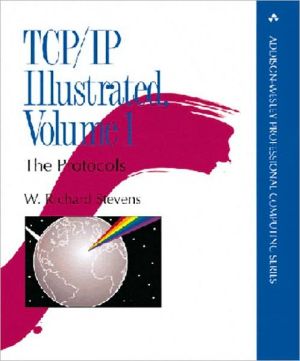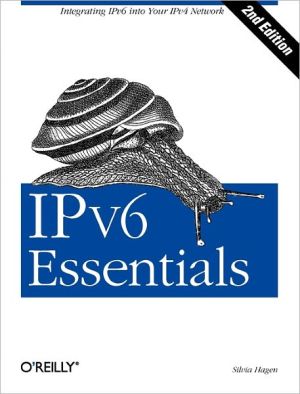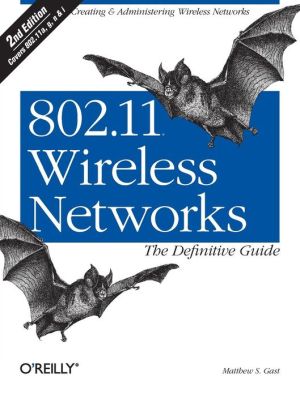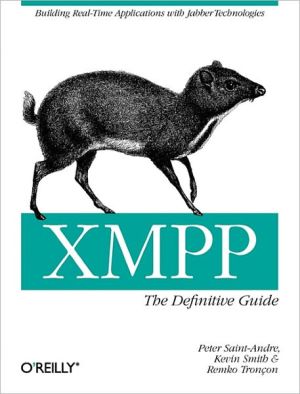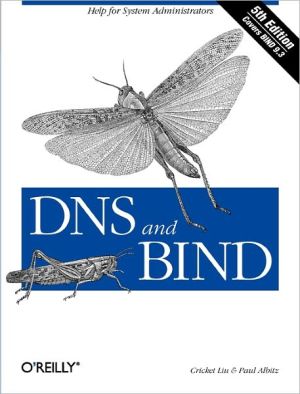TCP/IP Illustrated, Volume 1: The Protocols
TCP/IP Illustrated is a complete and detailed guide to the entire TCP/IP protocol suite-with an important difference from other books on the subject. Rather than just describing what the RFCs say the protocol suite should do, this unique book uses a popular diagnostic tool so you may actually watch the protocols in action.By forcing various conditions to occur-such as connection establishment, timeout and retransmission, and fragmentation-and then displaying the results, TCP/IP Illustrated...
Search in google:
TCP/IP Illustrated is a complete and detailed guide to the entire TCP/IP protocol suite-with an important difference from other books on the subject. Rather than just describing what the RFCs say the protocol suite should do, this unique book uses a popular diagnostic tool so you may actually watch the protocols in action.By forcing various conditions to occur-such as connection establishment, timeout and retransmission, and fragmentation-and then displaying the results, TCP/IP Illustrated gives you a much greater understanding of these concepts than words alone could provide. Whether you are new to TCP/IP or you have read other books on the subject, you will come away with an increased understanding of how and why TCP/IP works the way it does, as well as enhanced skill at developing applications that run over TCP/IP. With this unique approach, TCP/IP Illustrated presents the structure and function of TCP/IP from the link layer up through the network, transport, and application layers. You will learn about the protocols that belong to each of these layers and how they operate under numerous implementations, including Sun OS 4.1.3, Solaris 2.2, System V Release 4, BSD/386TM, AIX 3.2.2, and 4.4BSD.In TCP/IP Illustrated you will find the most thorough coverage of TCP available - 8 entire chapters. You will also find coverage of the newest TCP/IP features, including multicasting, path MTU discovery, and long fat pipes. "While all of Stevens' books are excellent, this new opus (TCP/IP Illustrated, Volume 1) is awesome. Although many books describe the TCP/IP protocols, the author provides a level of depth and real-world detail lacking from the competition."- Unix Review "This book (TCP/IP Illustrated, Volume 1) is a stone jewel...Written by W. Richard Stevens, this book probably provides the most comprehensive view of TCP/IP available today in print."- Boardwatch "The diagrams he uses are excellent and his writing style is clear and readable. Please read it (TCP/IP Illustrated, Volume 1) and keep it on your bookshelf."- Sys Admin "The word 'illustrated' distinguishes this book (TCP/IP Illustrated, Volume 1) from its many rivals. Stevens uses the Lawrence Berkeley Laboratories tcdump program to capture packets in promiscuous mode under a variety of OS and TCP/IP implementations. Studying tcdump output helps you understand how the various protocols work."- Unix Review Booknews A guide to the entire TCP/IP protocol suite, not just describing the protocols and what they do, but using a popular diagnostic tool to watch the protocols in action. Seeing how the protocols operate in various circumstances provides a greater understanding of how they work and why certain design decisions were made. Annotation c. Book News, Inc., Portland, OR (booknews.com)
PREFACE: \ Introduction\ This book describes the TCP/IP protocol suite, but from a different perspective than other texts on TCP/IP. Instead of just describing the protocols and what they do, we'll use a popular diagnostic tool to watch the protocols in action. Seeing how the protocols operate in varying circumstances provides a greater understanding of how they work and why certain design decisions were made. It also provides a look into the implementation of the protocols, without having to wade through thousands of lines of source code.\ When networking protocols were being developed in the 1960s through the 1980s, expensive, dedicated hardware was required to see the packets going "across the wire." Extreme familiarity with the protocols was also required to comprehend the packets displayed by the hardware. Functionality of the hardware analyzers was limited to that built in by the hardware designers.\ Today this has changed dramatically with the ability of the ubiquitous workstation to monitor a local area network Mogul 1990. Just attach a workstation to your network, run some publicly available software (described in Appendix A), and watch what goes by on the wire. While many people consider this a tool to be used for diagnosing network problems, it is also a powerful tool for understanding how the network protocols operate, which is the goal of this book.\ This book is intended for anyone wishing to understand how the TCP/IP protocols operate: programmers writing network applications, system administrators responsible for maintaining computer systems and networks utilizing TCP/IP, and users who deal with TCP/IP applications on a dailybasis.\ Organization of the Book\ We take a bottom-up approach to the TCP/IP protocol suite. After providing a basic introduction to TCP/IP in Chapter 1, we will start at the link layer in Chapter 2 and work our way up the protocol stack. This provides the required background for later chapters for readers who aren't familiar with TCP/IP or networking in general.\ This book also uses a functional approach instead of following a strict bottom-to-top order. For example, Chapter 3 describes the IP layer and the IP header. But there are numerous fields in the IP header that are best described in the context of an application that uses or is affected by a particular field. Fragmentation, for example, is best understood in terms of UDP (Chapter 11), the protocol often affected by it. The time-to-live field is fully described when we look at the Traceroute program in Chapter 8, because this field is the basis for the operation of the program. Similarly, many features of ICMP are described in the later chapters, in terms of how a particular ICMP message is used by a protocol or an application.\ We also don't want to save all the good stuff until the end, so we describe TCP/IP applications as soon as we have the foundation to understand them. Ping and Traceroute are described after IP and ICMP have been discussed. The applications built on UDP (multicasting, the DNS, TFTP, and BOOTP) are described after UDP has been examined. The TCP applications, however, along with network management, must be saved until the end, after we've thoroughly described TCP. This text focuses on how these applications use the TCP/IP protocols. We do not provide all the details on running these applications.\ Readers\ This book is self-contained and assumes no specific knowledge of networking or TCP/IP. Numerous references are provided for readers interested in additional details on specific topics.\ This book can be used in many ways. It can be used as a self-study reference and covered from start to finish by someone interested in all the details on the TCP/IP protocol suite. Readers with some TCP/IP background might want to skip ahead and start with Chapter 7, and then focus on the specific chapters in which they're interested. Exercises are provided at the end of the chapters, and most solutions are in Appendix D. This is to maximize the usefulness of the text as a self-study reference.\ When used as part of a one- or two-semester course in computer networking, the focus should be on IP (Chapters 3 and 9), UDP (Chapter 11), and TCP (Chapters 17-24), along with some of the application chapters.\ Many forward and backward references are provided throughout the text, along with a thorough index, to allow individual chapters to be studied by themselves. A list of all the acronyms used throughout the text, along with the compound term for the acronym, appears on the inside back covers.\ If you have access to a network you are encouraged to obtain the software used in this book (Appendix F) and experiment on your own. Hands-on experimentation with the protocols will provide the greatest knowledge (and make it more fun).\ Systems Used for Testing\ Every example in the book was run on an actual network and the resulting output saved in a file for inclusion in the text. Figure 1.11 (p. 18) shows a diagram of the different hosts, routers, and networks that are used. (This figure is also duplicated on the inside front cover for easy reference while reading the book.) This collection of networks is simple enough that the topology doesn't confuse the examples, and with four systems acting as routers, we can see the error messages generated by routers.\ Most of the systems have a name that indicates the type of software being used: bsdi, svr4, sun, solaris, aix, slip, and so on. In this way we can identify the type of software that we're dealing with by looking at the system name in the printed output.\ A wide range of different operating systems and TCP/IP implementations are used:\ \ BSD/386 Version 1.0 from Berkeley Software Design, Inc., on the hosts named bsdi and slip. This system is derived from the BSD Networking Software, Release 2.0. (We show the lineage of the various BSD releases in Figure 1.10 on p. 17.)\ Unix System V/386 Release 4.0 Version 2.0 from U.H. Corporation, on the host named svr4. This is vanilla SVR4 and contains the standard implementation of TCP/IP from Lachman Associates used with most versions of SVR4.\ SunOS 4.1.3 from Sun Microsystems, on the host named sun. The SunOS 4.1.x systems are probably the most widely used TCP/IP implementations. The TCP/IP code is derived from 4.2BSD and 4.3BSD.\ Solaris 2.2 from Sun Microsystems, on the host named solaris. The Solaris 2.x systems have a different implementation of TCP/IP from the earlier SunOS 4.1.x systems, and from SVR4. (This operating system is really SunOS 5.2, but is commonly called Solaris 2.2.)\ AIX 3.2.2 from IBM on the host named aix. The TCP/IP implementation is based on the 4.3BSD Reno release.\ 4.4BSD from the Computer Systems Research Group at the University of California at Berkeley, on the host vangogh.cs.berkeley.edu. This system has the latest release of TCP/IP from Berkeley. (This system isn't shown in the figure on the inside front cover, but is reachable across the Internet.)\ \ Although these are all Unix systems, TCP/IP is operating system independent, and is available on almost every popular non-Unix system. Most of this text also applies to these non-Unix implementations, although some programs (such as Traceroute) may not be provided on all systems.\ Typographical Conventions\ When we display interactive input and output we'll show our typed input in a bold font, and the computer output like this. Comments are added in italics.\ Also, we always include the name of the system as part of the shell prompt (bsdi in this example) to show on which host the command was run.\ Throughout the text we'll use indented, parenthetical notes such as this to describe historical points or implementation details.\ We sometimes refer to the complete description of a command in the Unix manual as in ifconfig(8). This notation, the name of the command followed by a number in parentheses, is the normal way of referring to Unix commands. The number in parentheses is the section number in the Unix manual of the "manual page" for the command, where additional information can be located. Unfortunately not all Unix systems organize their manuals the same, with regard to the section numbers used for various groupings of commands. We'll use the BSD-style section numbers (which is the same for BSD-derived systems such as SunOS 4.1.3), but your manuals may be organized differently.\ Acknowledgments\ Although the author's name is the only one to appear on the cover, the combined effort of many people is required to produce a quality text book. First and foremost is the author's family, who put up with the long and weird hours that go into writing a book. Thank you once again, Sally, Bill, Ellen, and David.\ The consulting editor, Brian Kernighan, is undoubtedly the best in the business. He was the first one to read various drafts of the manuscript and mark it up with his infinite supply of red pens. His attention to detail, his continual prodding for readable prose, and his thorough reviews of the manuscript are an immense resource to a writer.\ Technical reviewers provide a different point of view and keep the author honest by catching technical mistakes. Their comments, suggestions, and (most importantly) criticisms add greatly to the final product. My thanks to Steve Bellovin, Jon Crowcroft, Pete Haverlock, and Doug Schmidt for comments on the entire manuscript. Equally valuable comments were provided on portions of the manuscript by Dave Borman, Tony DeSimone, Bob Gilligan, Jeff Gitlin, John Gulbenkian, Tom Herbert, Mukesh Kacker, Barry Margolin, Paul Mockapetris, Burr Nelson, Steve Rago, James Risner, Chris Walquist, Phil Winterbottom, and Gary Wright. A special thanks to Dave Borman for his thorough review of all the TCP chapters, and to Bob Gilligan who should be listed as a coauthor for Appendix E.\ An author cannot work in isolation, so I would like to thank the following persons for lots of small favors, especially by answering my numerous e-mail questions: Joe Godsil, Jim Hogue, Mike Karels, Paul Lucchina, Craig Partridge, Thomas Skibo, and Jerry Toporek.\ This book is the result of my being asked lots of questions on TCP/IP for which I could find no quick, immediate answer. It was then that I realized that the easiest way to obtain the answers was to run small tests, forcing certain conditions to occur, and just watch what happens. I thank Pete Haverlock for asking the probing questions and Van Jacobson for providing so much of the publicly available software that is used in this book to answer the questions.\ A book on networking needs a real network to work with along with access to the Internet. My thanks to the National Optical Astronomy Observatories (NOAO), especially Sidney Wolff, Richard Wolff, and Steve Grandi, for providing access to their networks and hosts. A special thanks to Steve Grandi for answering lots of questions and providing accounts on various hosts. My thanks also to Keith Bostic and Kirk McKusick at the U.C. Berkeley CSRG for access to the latest 4.4BSD system.\ Finally, it is the publisher that pulls everything together and does whatever is required to deliver the final product to the readers. This all revolves around the editor, and John Wait is simply the best there is. Working with John and the rest of the professionals at Addison-Wesley is a pleasure. Their professionalism and attention to detail show in the end result.\ Camera-ready copy of the book was produced by the author, a Troff die-hard, using the Groff package written by James Clark. I welcome electronic mail from any readers with comments, suggestions, or bug fixes.\ W. Richard Stevens\ rstevens@noao.edu\ Tucson, Arizona\ October 1993\ \ \
1. Introduction. Introduction. Layering. TCP/IP Layering. Internet Addresses. The Domain Name System. Encapsulation. Demultiplexing. Client-Server Model. Port Numbers. Standardization Process. RFCs. Standard, Simple Services. The Internet. Implementations. Application Programming Interfaces. Test Network. Summary. 2. Link Layer. Introduction. Ethernet and IEEE 802 Encapsulation. Trailer Encapsulation. SLIP: Serial Line IP. Compressed SLIP. PPP: Point-to-Point Protocol. Loopback Interface. MTU. Path MTU. Serial Line Throughput Calculations. Summary. 3. IP: Internet Protocol. Introduction. IP Header. IP Routing. Subnet Addressing. Subnet Mask. Special Case IP Addresses. A Subnet Example. ifconfig Command. netstat Command. IP Futures. Summary. 4. ARP: Address Resolution Protocol. Introduction. An Example. ARP Cache. ARP Packet Format. ARP Examples. Proxy ARP. Gratuitous ARP. arpCommand. Summary. 5. RARP: Reverse Address Resolution Protocol. Introduction. RARP Packet Format. RARP Examples. RARP Server Design. Summary. 6. ICMP: Internet Control Message Protocol. Introduction. ICMP Message Types. ICMP Address Mask Request and Reply. ICMP Timestamp Request and Reply. ICMP Port Unreachable Error. 4.4BSD Processing of ICMP Messages. Summary. 7. Ping Program. Introduction. Ping Program. IP Record Route Option. IP Timestamp Option. Summary. 8. Traceroute Program. Introduction. Traceroute Program Operation. LAN Output. WAN Output. IP Source Routing Option. Summary. 9. IP Routing. Introduction. Routing Principles. ICMP Host and Network Unreachable Errors. To Forward or Not to Forward. ICMP Redirect Errors. ICMP Router Discovery Messages. Summary. 10. Dynamic Routing Protocols. Introduction. Dynamic Routing. Unix Routing Daemons. RIP: Routing Information Protocol. RIP Version 2. OSPF: Open Shortest Path First. BGP: Border Gateway Protocol. CIDR: Classless Interdomain Routing. Summary. 11. UDP: User Datagram Protocol. Introduction. UDP Header. UDP Checksum. A Simple Example. IP Fragmentation. ICMP Unreachable Error (Fragmentation Required). Determining the Path MTU Using Traceroute. Path MTU Discovery with UDP. Interaction Between UDP and ARP. Maximum UDP Datagram Size. ICMP Source Quench Error. UDP Server Design. Summary. 12. Broadcasting and Multicasting. Introduction. Broadcasting. Broadcasting Examples. Multicasting. Summary. 13. IGMP: Internet Group Management Protocol. Introduction. IGMP Message. IGMP Protocol. An Example. Summary. 14. DNS: The Domain Name System. Introduction. DNS Basics. DNS Message Format. A Simple Example. Pointer Queries. Resource Records. Caching. UDP or TCP. Another Example. Summary. 15. TFTP: Trivial File Transfer Protocol. Introduction. Protocol. An Example. Security. Summary. 16. BOOTP: Bootstrap Protocol. Introduction. BOOTP Packet Format. An Example. BOOTP Server Design. BOOTP Through a Router. Vendor-Specific Information. Summary. 17. TCP: Transmission Control Protocol. Introduction. TCP Services. TCP Header. Summary. 18. TCP Connection Establishment and Termination. Introduction. Connection Establishment and Termination. Timeout of Connection Establishment. Maximum Segment Size. TCP Half-Close. TCP State Transition Diagram. Reset Segments. Simultaneous Open. Simultaneous Close. TCP Options. TCP Server Design. Summary. 19. TCP Interactive Data Flow. Introduction. Interactive Input. Delayed Acknowledgments. Nagle Algorithm. Window Size Advertisements. Summary. 20. TCP Bulk Data Flow. Introduction. Normal Data Flow. Sliding Windows. Window Size. PUSH Flag. Slow Start. Bulk Data Throughput. Urgent Mode. Summary. 21. TCP Timeout and Retransmission. Introduction. Simple Timeout and Retransmission Example. Round-Trip Time Measurement. An RTT Example. Congestion Example. Congestion Avoidance Algorithm. Fast Retransmit and Fast Recovery Algorithms. Congestion Example (Continued). Per-Route Metrics. ICMP Errors. Repacketization. Summary. 22. TCP Persist Timer. Introduction. An Example. Silly Window Syndrome. Summary. 23. TCP Keepalive Timer. Introduction. Description. Keepalive Examples. Summary. 24. TCP Futures and Performance. Introduction. Path MTU Discovery. Long Fat Pipes. Window Scale Option. Timestamp Option. PAWS: Protection Against Wrapped Sequence Numbers. T/TCP: A TCP Extension for Transactions. TCP Performance. Summary. 25. SNMP: Simple Network Management Protocol. Introduction. Protocol. Structure of Management Information. Object Identifiers. Introduction to the Management Information Base. Instance Identification. Simple Examples. Management Information Base (Continued). Additional Examples. Traps. ASN.1 and BER. SNMP Version 2. Summary. 26. Telnet and Rlogin: Remote Login. Introduction. Rlogin Protocol. Rlogin Examples. Telnet Protocol. Telnet Examples. Summary. 27. FTP: File Transfer Protocol. Introduction. FTP Protocol. FTP Examples. Summary. 28. SMTP: Simple Mail Transfer Protocol. Introduction. SMTP Protocol. SMTP Examples. SMTP Futures. Summary. 29. NFS: Network File System. Introduction. Sun Remote Procedure Call. XDR: External Data Representation. Port Mapper. NFS Protocol. NFS Examples. NFS Version 3. Summary. 30. Other TCP/IP Applications. Introduction. Finger Protocol. Whois Protocol. Archie, WAIS, Gopher, Veronica, and X Window System. Summary. Appendix A. The tcpdump Program. BSD Packet Filter. SunOS Network Interface Tap. SVR4 Data Link Provider Interface. tcpdump Output. Security Considerations. Socket Debug Option. Appendix B. Computer Clocks. Appendix C. The sock Program. Appendix D. Solutions to Selected Exercises. Appendix E. Configurable Options. BSD/386 Version 1.0. SunOS 4.1.3. System V Release 4. Solaris 2.2. AIX 3.2.2. 4.4BSD. Appendix F. Source Code Availability. Bibliography. Index. 0201633469T04062001
\ From Barnes & Noble\ \ Fatbrain Review\ With a hands-on approach to studying, this best-selling guide explains TCP/IP protocols. In eight chapters, it provides the most thorough coverage of TCP available. It also covers the newest TCP/IP features, including multicasting, path MTU discovery and long fat pipes. \ The author describes various protocols, including ARP, ICMP and UDP. He utilizes network diagnostic tools to actually show the protocols in action. He also explains how to avoid silly window syndrome (SWS) by using numerous helpful diagrams. This book gives you a broader understanding of concepts like connection establishment, timeout, retransmission and fragmentation. It is ideal for anyone wanting to gain a greater understanding of how the TCP/IP protocols work.\ \ \ \ \ \ BooknewsA guide to the entire TCP/IP protocol suite, not just describing the protocols and what they do, but using a popular diagnostic tool to watch the protocols in action. Seeing how the protocols operate in various circumstances provides a greater understanding of how they work and why certain design decisions were made. Annotation c. Book News, Inc., Portland, OR (booknews.com)\ \
